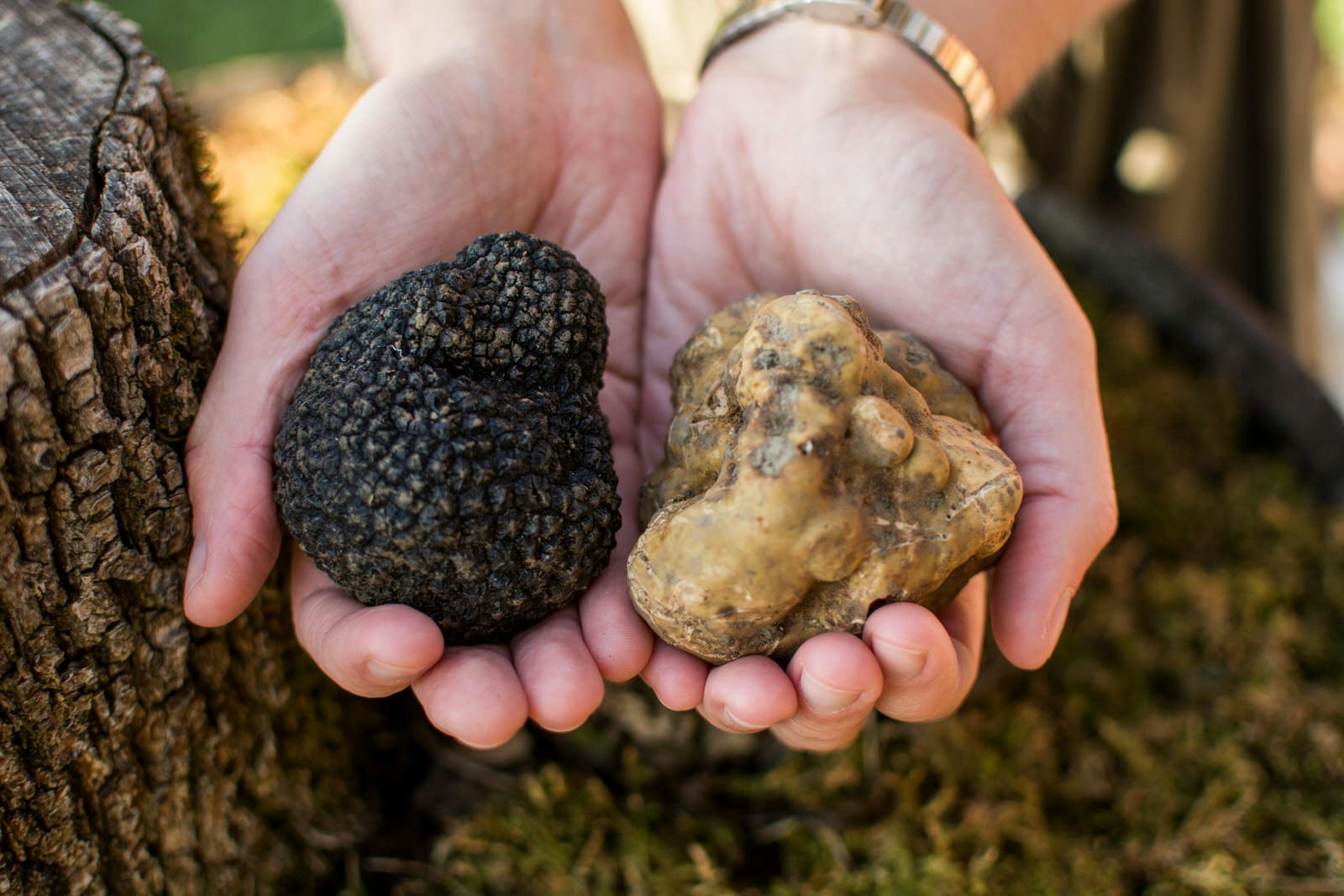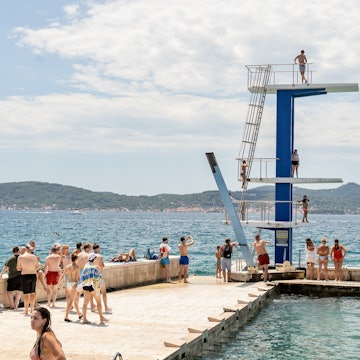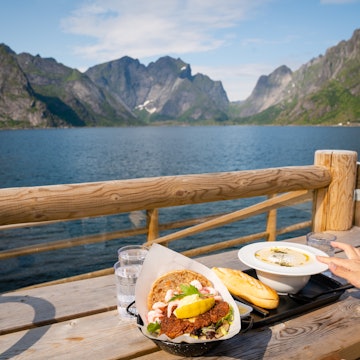

The region of Istria offers some of Croatia’s best foodie experiences, from dining on fresh seafood and hunting for truffles, to tasting top-quality extra virgin olive oil, wines and spirits.
At the northern end of Croatia’s coastline, the Istrian peninsula is often divided into two distinct regions: Blue Istria, the sparkling coast, and Green Istria, the lush interior.

With its rolling hills swathed in vineyards and olive groves and topped by medieval hill towns, it’s not surprising that Istria is often compared with Tuscany. The cuisine has a distinctly Italian flavour too, featuring fresh handmade pasta and air-cured pršut ham and using simple preparations to showcase high-quality seasonal ingredients.
Truffle hunting as a way of life
Višnja Prodan’s family have been hunting truffles for three generations. She has trained her dogs from a young age to have a taste for truffles, and they can sniff out the pungent fungi as they begin to ripen underground. The family own 25,000 square metres of land in the hills near Buzet which are thick with oak, beech and hazel trees that have truffles living symbiotically in their root systems. For the Prodans no dish is complete without truffles, and they liberally sprinkle the flavourful shavings on all of their meals as if it were salt.

Truffles were initially discovered in Istria by accident as farmers dug up their vegetables. Locals called them ‘smelly potatoes’ and fed them to their pigs, until Italians turned up trying to buy them at rock-bottom prices. Both black truffles and the more precious white truffles are found here, making Istria the only place that white truffles are found outside of Italy. The Istrian truffle scene took off in 1999, when Giancarlo Zigante and his dog Diana dug up a 1.3kg white truffle, at the time the largest ever found.
Visitors can join Višnja and her dogs Stiv and Brum (named after the truffle varieties Tuber aestivum and Tuber brumale) as they scamper through the woods, sniffing eagerly at the ground. When the dogs detect a truffle, they scratch at the ground to show Višnja where it is, and are rewarded with a treat. Black truffles are found all year round, but if you want to hunt for and taste white truffles you’ll need to visit between October and December, when they are in season.

If, like the Prodans, you can’t get enough of truffles, it’s worth making a visit to Restaurant Zigante, owned by Giancarlo Zigante. The chefs at this fancy gastronomic establishment prepare just six truffle-centric dishes each day, and serve them with wine pairings and much ceremony. Every course includes fresh truffles, right down to truffle ice cream for dessert, and the only choice you need to make is how many courses you want to have.
The world’s finest extra virgin olive oil
Istrian olive oil was prized in Roman times – a huge number of Roman olive presses have been found in Barbariga on the coast, and olive oil amphoras exported from Fažana have been found across the Roman Empire. More recently, Istria has been recognised for several years running by the highly respected Flos Olei competition as the region with the most top-quality extra virgin olive oil producers in the world.

As olives ripen the quantity of oil they contain increases and it becomes easier to extract, but the quality of that oil declines. Around 20 years ago, Istrian pioneers such as Ipša decided to focus on producing high-quality extra virgin olive oil and began harvesting their olives earlier. After picking, olives are ground into a paste, then pressed to extract the oil. This process is done as quickly as possible (a matter of hours from the tree to the bottle), and inert gases such as argon and nitrogen are used to prevent oxidisation.
At Ipša in the hills north of Motovun the focus is on fully organic production, showcasing the qualities of different olive varieties. Three of the four oils they produce are each made from a single variety of olive: Istarska bjelica, a tough green olive that doesn’t produce much oil but is known for its spiciness, frantoio, which has a very herbal aromatic taste, and leccino, which is more bitter on the tongue. At Chiavalon in Vodnjan near the coast, most of the oils are carefully balanced blends. The lighter more herbal Romano blend is intended to be used with fish, whilst the stronger, spicier and more bitter Atilio blend is designed to be served with meat.

Many of Istria’s olive oil producers offer tastings if you book in advance. You’ll be shown how to warm it up in a glass in your hand, sniffing for different herbal or fruity notes such as freshly cut grass, green apples or rosemary, then taste some by sucking air across your tongue to help detect any bitterness or spiciness. The House of Istrian Olive Oil in Pula is a great place to try oils from multiple producers. It also has an olive oil museum and a shop selling oils by 30 top Istrian producers, as well as other Istrian products, such as wine, rakija and truffles. When shopping for olive oil, look for dark-coloured glass bottles, as light spoils the oil. Store it at room temperature – a sealed bottle will keep for a year and a half, but an opened bottle should be consumed within 4 months.
Fish and seafood plucked fresh from the Adriatic
The Istrian peninsula is surrounded by the Adriatic sea, which is home to over 400 species of fish. The main fishing ports on the west coast include Fažana, Novigrad and Rovinj, and the daily catch includes anchovies, sardines, red and grey mullet, scampi, shrimp, spider crab, octopus, squid and sea urchins. Traditionally fish is prepared very simply, grilled with olive oil, so that the flavour of the fresh fish is front and centre. Konoba Astarea is a great place to try grilled seafood, as they have an open fire grill in the restaurant’s seating area, so you can watch your meal being cooked. The fish is all super-fresh, caught by local fishermen that morning or the previous evening, and a highlight of the menu is the deliciously delicate and simple scallops, grilled with olive oil, konjac and wine.

For something a little more sophisticated, make a pilgrimage to Konoba Batelina on the outskirts of Pula. It’s a family restaurant, run by father-and-son team Danilo and David. Father Danilo is fisherman, and 60 percent of the seafood served in the restaurant comes from his morning catch. The menu changes according to what is available that day, and the restaurant closes in August, when the local fishing isn’t good enough to sustain it. Son David is the chef, and became famous locally after appearing on Masterchef. The homely restaurant, with rough stone walls, contrasts with the sophistication of the dishes on offer. The generous spread of appetisers includes dishes such as white bream carpaccio served with olive oil and ‘fake caviar’, made from tapioca in oyster sauce.
Authentic natural wines made with expertise and passion
Istria is blessed with the perfect climate and terrain for winemaking, its rolling hills tousled by mild and dependable sea breezes. The local limestone geology makes for an interesting variety of terroir, with a number of different soil types, including terra rossa – a rich rusty-red, pH-neutral soil found in western Istria, and terra blanca – the mineral white-marl soil of central and eastern Istria. However, until 1992 wine was bulk-produced by state cooperatives that emphasised quantity over quality. Much of the contemporary wine scene is a direct reaction against that philosophy, with an emphasis on natural, traditional processes that allow local accents and idiosyncrasies to express themselves.
Many producers follow organic principles, and as a result favour local grape varieties that are adapted to the environment and therefore less susceptible to pests and diseases. The most widely cultivated is malvazija Istarska, a white that when young and fresh has a fruity and floral nose with notes of acacia flowers, green apples and citrus, plenty of body, and a nutty mineral finish. The most popular local red is Teran, a rich, robust ruby-red wine, with strong acidity and tannins, and hints of wild berries and pepper.

Self-educated winemaker Mladen Rožanić has a passion for natural, spontaneous and honest wines, and a strong belief in the ageing process. He follows traditional methods of minimal interference winemaking, utilising spontaneous fermentation by indigenous yeasts that are already on the grapes and long maceration that allows natural tannins from the skins and seeds to enrich the wine. The vast new Roxanich winery is an engineering marvel tucked into the hillside near Motovun. It is connected via a tunnel to a striking 32-room design hotel and top-quality gastronomic restaurant, with views over the Mirna valley.
The Kabola vineyard is located on a hill near Momjan, with views to the Adriatic sea and the Dolomites mountains beyond. The family has been producing wine since 1891, and they specialise in organic wines macerated for six months in Georgian amphorae, allowing the wine to absorb some of the clay aroma.
Bottling the wild spirits of Istria
An unusual exchange takes place at Destilerija Aura. Locals turn up with bags of leaves, or tiny, tart wild apples and pears, and leave with bottles of rakija, a popular local fruit brandy. The seemingly worthless wild fruits and leaves are used by the family-run company to flavour its spirits, as they exude more powerful flavours than cultivated varieties. The business started in their home cellar in Buzet old town, but they opened this pungently fruity new distillery and shop in an old winery five years ago.

To make rakija, 400 kilos of apples, pears, grapes or plums are fermented using yeast, then distilled make 40 litres of 50-percent proof alcohol. Next is the maceration, where wild fruits or herbs are steeped in the alcohol for up to six months to give it flavour and colour. Their most famous product is Teranino, made from Teran wine, fruit brandy and a secret blend of ten spices. Another product unique to Istria is biska, a strong but smooth rakija made with mistletoe leaves. In addition to over 20 varieties of rakija and a gin, they also make several jams, with unusual flavours like dandelion (which tastes a bit like marmalade), alongside classics like raspberry and blackberry.
Anna Tyler travelled to Istria with support from the Croatian National Tourist Office and the Istria Tourist Board. Lonely Planet contributors do not accept freebies in exchange for positive coverage.
https://shop.lonelyplanet.com/products/croatia-travel-guide-10















